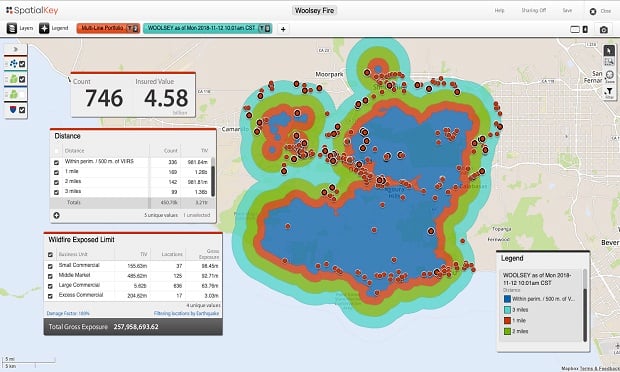 Shown above is NASA fire perimeter data from the Woolsey fire in California. This data has built-in buffers set at 1, 2 and 3 miles from the perimeter. Insurers can join portfolios to understand which insureds are inside the perimeter and apply buffers and filters to understand TIV and/or policy exposed limits.
Shown above is NASA fire perimeter data from the Woolsey fire in California. This data has built-in buffers set at 1, 2 and 3 miles from the perimeter. Insurers can join portfolios to understand which insureds are inside the perimeter and apply buffers and filters to understand TIV and/or policy exposed limits.
Wildfires, like tornadoes, can leave one property leveled and its neighbor unscathed — jumping houses, neighborhoods and boundaries with seemingly no rhyme or reason.
Consider the devastation of 2018′s Camp Fire, which consumed everything in its path and leveled the town of Paradise. And that's distinct from what happened in Malibu with the Woolsey Fire, which hopped the Pacific Coast highway.
Recommended For You
Want to continue reading?
Become a Free PropertyCasualty360 Digital Reader
Your access to unlimited PropertyCasualty360 content isn’t changing.
Once you are an ALM digital member, you’ll receive:
- Breaking insurance news and analysis, on-site and via our newsletters and custom alerts
- Weekly Insurance Speak podcast featuring exclusive interviews with industry leaders
- Educational webcasts, white papers, and ebooks from industry thought leaders
- Critical converage of the employee benefits and financial advisory markets on our other ALM sites, BenefitsPRO and ThinkAdvisor
Already have an account? Sign In Now
© 2025 ALM Global, LLC, All Rights Reserved. Request academic re-use from www.copyright.com. All other uses, submit a request to [email protected]. For more information visit Asset & Logo Licensing.








